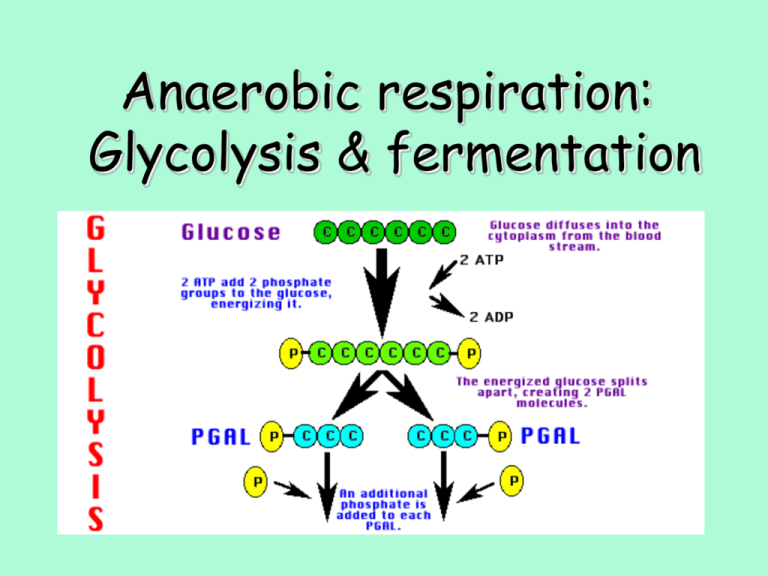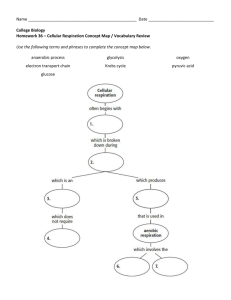Cells and Energy Use
advertisement

Anaerobic respiration: Glycolysis & fermentation What is the definition of cellular respiration? • Energy is obtained by breaking down food molecules. • Energy is stored in ATP. • Covalent bond energy is converted to ATP energy. A panda is very poor at digesting bamboo and so must spend much of its day eating. How is energy transferred during cellular respiration? • Most reactions involving energy transfer are electron transferring reactions. • Oxidation: an electron being taken from a molecule • Reduction: an electron being added to a molecule Hint: to remember think the molecule is reduced in charge from + to – when an electron is transferred. balanced equation for cellular respiration – Glucose + Oxygen Carbon dioxide + Water + 36 ATPs – C6H12O6 + O2 CO2 + H2O – C6H12O6 + 6 O2 6 CO2 + 6 H2O • The three processes that make up cellular respiration and where they occur: – Glycolysis - cytoplasm (anaerobic) – Krebs cycle - mitochondria (aerobic) – Electron transport system - mitochondria (aerobic) the first stage of Cellular Respiration: Glycolysis • glycolysis occurs in the cytoplasm of all cells. • Does not use oxygen, it’s anaerobic – Glycolysis is a series of 10 reactions. – Each produces a product used by the next. Glycolysis in a nutshell • • • • Reactant: 1 Glucose molecule. Product: 2 Pyruvic acids molecules 2 ATP are need to start the reaction 4 ATP are produced so….. 2 ATP are gained • NAD+ stores 1 electron & a hydrogen to be used later. Do you know the expression: “it takes money to make money?” (like a loan to start a business.) Well, it takes energy to get energy out of a large molecule The next step in the absence of oxygen gas: fermentation • Yeasts: Pyruvic acid is converted into ethyl alcohol and CO2 – Yeast + grape juice = wine – Yeast + bread dough makes it rise Yeast cells Dough rising •What is the point of fermentation if no ATP is produce? •To oxidize NADH into NAD+ to be used in Glycolysis Fermentation in animal cells • Animals: Pyruvic acid is converted lactic acid – Lactic acid can build up in muscles and cause fatigue Muscles produce lactic acid when short of oxygen Energy Yield • Glycolysis is about 2% efficient. • Simple organisms such as bacteria survive on anaerobic respiration. • More complex organisms require more energy. Review 1. What are the reactants and produces of Glycolysis? 2. What is the net yield of ATP from glycolysis? 3. What is the point of fermentation (other than all the useful or yummy products)?


